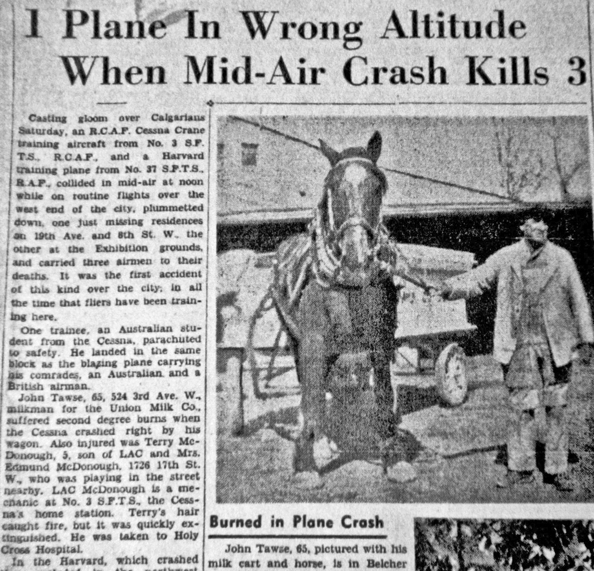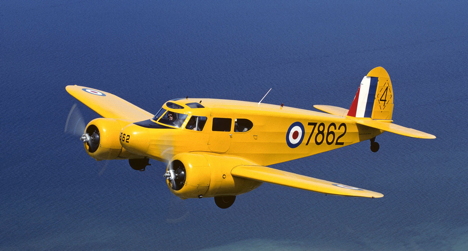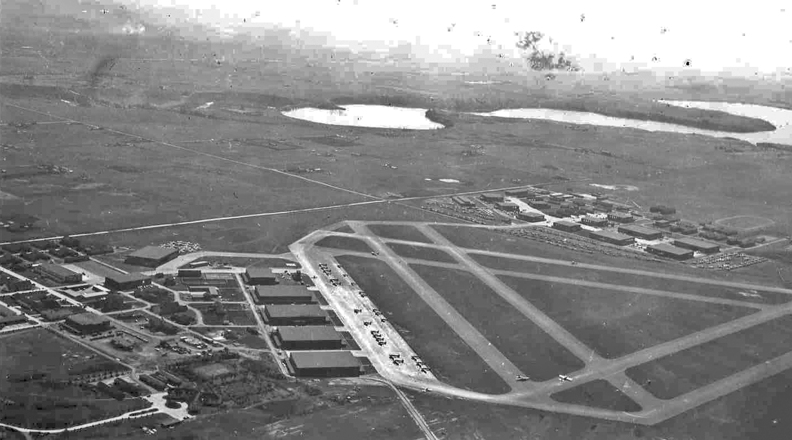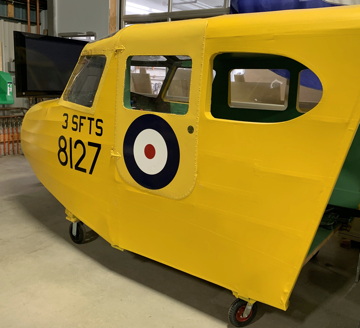 BCATP
BCATP  |
Lancaster
|
Media
|
Lancaster
|
Media
 BCATP
BCATP  |
Lancaster
|
Media
|
Lancaster
|
Media

|
On August 28 1943, Cessna Crane 8127 had just completed a bombing training exercise and was preparing to land at 3 Service Flying Training School, now the site of Mount Royal University. A 37 Service Flying Training School Harvard had been practicing formation flying and was on a southerly course over the city planning to turn and then land at what is now the Calgary airport. Suddenly, the Harvard and Crane collided. A wing was torn of the Crane which plunged to the ground onto the boulevard in front of 839 -19th Avenue SW, just south of downtown. The Harvard's pilot, LAC J. Major, tried desperately to control his damaged aircraft. It circled the Stampede grounds, eventually crashing into the infield and exploding, killing LAC Major. LAC J.L. Ayton had been sitting near the door of the Crane. He was able to jump, deployed his parachute, and landed near the wreckage on 19th Avenue. The pilot, Sgt. J.D. Hardiman, and student pilot LAC M.V. Eckert were killed. Seriously burned when the Crane exploded were milkman John Tawes and five year old Terry McDonough, who often accompanied John on his rounds along 19th Avenue. The milkman's horse had to be put down. Terry recovered and became a pilot in the RCAF. |
Saturday, August 28, 1943 was a beautiful sunny day in Calgary. A clear sky and warm temperatures saw Calgarians enjoying a relaxing weekend. People shopped, worked around their homes and took part in favorite pastimes. The war, raging in other parts of the world, seemed somehow distant and remote on that beautiful weekend.
At Victoria Park, home of the Calgary Stampede, local riders were working their horses, getting ready for the Powder Puff Derby. Arthur Ferguson, the grounds superintendent, was in the infield with Herb Johnson, who was in charge of the Derby, while Arn Gill made adjustments to the public address system.
Mrs A. McAloney and her daughter Doris were on their front porch on College Lane enjoying the day. Ted Gates was relaxing on his upstairs porch watching planes from nearby Currie Airfield, home of No. 3 SFTS (Service Flying Training School), flying overhead. A visitor from Winnipeg, J. M. Sutherland, was strolling along 11 Avenue, occasionally glancing up at aircraft as they passed over the city. A. E. Perkins was on a scaffold as he made repairs to a house near the Anderson Apartments.
At the Stevens home, located at 839-19 Avenue West, Mrs. Stevens was catching up on housekeeping chores while her two children, Elizabeth, age nine, and Tommy, age ten, cleaned the windows at the front of the house. Their mother had promised that once finished, they could go and play in the back yard with June Gilbertson, visiting from Hughenden with Mrs J. O. Dale, who lived at the back of the house with her infant daughter. In the front room of the house, rented to LAC (Leading Aircraftman) and Mrs. F. O. Spooner, Mrs. Spooner sat before the freshly washed and now open window and finished writing a letter before leaving the house to catch the streetcar on 17 Avenue. Upstairs, after his night shift at the Ogden munitions shop, Mr. Stevens slept soundly.
 |
North of the city at the Municipal Airport, a flight of Harvard II single-engine advance trainers took off to practice formation flying north of the airfield. The aircraft belonged to No. 37 SFTS, one of ten advanced flying training schools initially set up by the Canadian Government at the outbreak of war for pilots of Great Britain's Royal Air Force. Piloting one of the Harvards (AJ796) was British pilot-in-training LAC J. Major, a native of Taunton, England. |
Five-year-old Terry McDonough, son of LAC and Mrs. Edmond McDonough, was sitting on the curb near the Stevens' house. He was waiting for John Tawes, a veteran Union Milk deliveryman, and Tawes' horse and wagon. Terry often accompanied Tawes for a couple of blocks each day, mainly for the chunks of ice Tawes would give him to chew on. Tawes was about to make his usual milk deliver to the home of Mrs. Buchan located next door to the Stevens house. Terry's father was at work at No. 3 Service Flying Training School at Currie Airfield.
Earlier in the morning, a Cessna Crane twin-engine training aircraft (8127) had taken off from Currie Field to practice bombing procedures west of the city. In charge of the flight was flying instructor Sergeant J. D. Hardiman, an Australian. With him were student pilots LAC M. V. Eckert from England and LAC J. L. Ayton of Australia. Over the course of the exercise, the students would take turns operating the aircraft from the co-pilot's seat beside the instructor. |
 |
Having finished with their window cleaning chores, Elizabeth and Tommy Stevens went to the back yard to play with their new friend June Gilbertson and other children from the neighborhood.
At approximately 11:20, LAC Major, piloting his Harvard II, was ordered to break off from the formation and return to the Municipal Airport. His return flight brought him south over the city on the downwind leg of his approach for an anticipated south to north approach to the active runway. Likely enjoying a few minutes of unsupervised flying, Major carried out a loop, followed by a dive, and then another loop.
In the backyard of the Steven's home, play was progressing well. A new game was thought up whereby June Gilbertson was tied to a corner of the house.
With the bombing exercise completed, the Cessna Crane turned east for its return to Currie Field. Hardiman and Eckert were in the pilot and co-pilot seats while Ayton rode home at the back of the small cabin, sitting beside the entry door.
Jimmy Arney, 13, was watching the aircraft. He was drawn to the Harvard because of its aerial maneuvering. Suddenly, the Harvard collided with the Cessna Crane, tearing off one of its wings. Both planes separated and fell away in different directions. Without any means of control, the Cessna fell in a northwesterly direction, with engines screaming and bits and pieces shedding as the aircraft dived. June Gilbertson, tied to the Steven's house, looked up to see a plummeting aircraft roaring straight down toward her and must have thought her young life was about to end.
Mrs. McAloney and her daughter heard "an awful roar and something shook the house. It made me look up and there were two planes which seemed just over our house and both were smoking." Ted Gates, observing from his upstairs porch, said he saw a wing drop off one of the aircraft and then one person bail out. The visitor from Winnipeg, J. M. Sutherland, watched as both aircraft collided. "I thought at first they were just maneuvering but soon one of the planes began spiraling as it went off in a westerly direction. Then I noticed the plane which I had first stopped to watch also was twisting and was going toward Victoria Park." Viewing the collision from his scaffold, A. E. Perkins watched as the aircraft came down and saw the Cessna explode and burst into fire. "One man bailed out before that and I saw a wing come off one of the aircraft."
In the Cessna, realizing what had just happened, LAC Ayton managed to get the door of the Cessna opened in order to jump. The door blew back, hitting him on the head, but he managed to clear the aircraft, expecting that the others would follow. As the aircraft dived, Ayton's parachute blossomed.
Returning to the milk wagon after delivering milk to Mrs. Buchan, John Tawes heard a sudden crescendo of sound and, glancing up, saw the Cessna diving earthward toward him. In an instant, the aircraft crashed into the boulevard, spewing ignited gasoline over Tawse, his horse and wagon and little Terry McDonough. Flames and wreckage shot out everywhere, terrifying the horse and setting it and the wagon on fire. With his hair and clothing ablaze, Terry McDonough fled the scene, following the part of the curb that he could see. As he ran toward his home, he somehow managed to beat out the fires on his body. Tawse was also badly burned but managed to lead the horse out of the flames before it bolted away down 19 Avenue.
In the Stevens house, Mrs. Stevens at first thought the sound was only a low-flying aircraft. Then she heard the sound of the crash just in front of her house. The crash and explosion woke Mr. Stevens who saw flames leaping up past the bedroom window. Fire from the explosion blew into the open front window where Mrs. Spooner had recently been writing and started the curtains on fire. Grabbing a dishpan full of water from the kitchen, Mrs. Stevens ran to the front room and doused the blaze.
In the back yard, the Stevens children, who not minutes before were washing that same window, watched as the aircraft dived down and crashed, narrowly missing the house. With great presence of mind, little Elizabeth ran to the fire call box on the corner and sent in the first alarm. Tommy said afterward that he looked up and saw the aircraft coming. "Then it disappeared and I felt the ground shudder. You couldn't see the plane, there was just smoke and flame." Across the street, Mrs. Gutman thought an aircraft was "careening over the house or flying low". Then she heard the explosion and thought a plane had hit her home. She rushed out and found pieces of the aircraft burning all around the house, on the roof and on the street.
Private R. Duhaime, stationed at Mewata Park Hospital, was near the crash on 19th Avenue. LAC Ayton landed near him and Duhaime helped get him to an army ambulance that happened to be passing by the crash scene. The ambulance took Duhaime and John Tawse to Colonel Belcher Hospital. Terry McDonough, meanwhile, ran two blocks to his home, somehow avoiding the ambulance, the driver of which yelled at him, "Get out of the way, kid. Can't you see there's been a plane crash!" He wasn't crying, he later told doctors, because he didn't want to frighten his mother, who immediately took him to Holy Cross Hospital.
Meanwhile, LAC Major tried desperately to control his damaged Harvard. The aircraft fell on a southerly heading then turned around to the north and circled the stampede grounds. Narrowly missing the stampede office, the plane crashed into the infield and exploded in flames. Arthur Ferguson, Arn Gill and Herb Johnson raced toward the blazing wreckage but the intense heat kept them from approaching too closely. Another Stampede employee, Bill Harding, telephoned the police, fire department, air force headquarters and the ambulance service. No one on the Stampede grounds was injured.
Within minutes, thousands of Calgarians flocked to both crash scenes and armed soldiers were immediately posted around the remains of the aircraft. Spectators trying to get a better view of the Harvard crash tore off boards from the infield fence. By late afternoon, however, air force personnel had removed the remains of the aircraft and their crewmembers.
The faraway war came quite sharply to Calgary on that sunny August Saturday. Killed in the crashes following the collision was Australian flying instructor Sergeant J. D. Hardiman and English student pilots LAC M. V. Eckert and LAC J. Major. Seriously burned were milkman John Tawes and Terry McDonough. The Union Milk Company's horse had to be put down.
Whether, in the aftermath of the crashes, the dreams of young June Gilbertson turned to nightmares can only be imagined.


During 2019, the museum completed the restoration of a Cessna Crane cockpit section which is the location of a flight simulator for use by museum visitors. In order to draw attention to the 'Mid-Air over Calgary' story, the BCATP's presence in the City of Calgary, and the tragic loss of Sgt. J.D. Hardiman, LAC M.V. Eckert, and LAC J. Major, the cockpit section carries the markings of Crane '8127' and the name of its school, '3 SFTS'. |

|